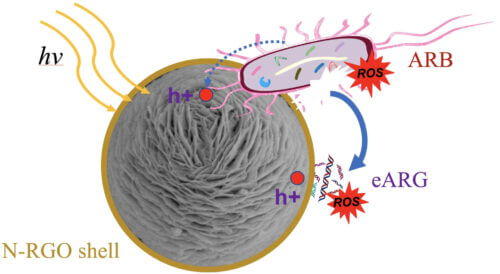Graphene shell helps particles destroy drug-resistant bacteria in wastewater treated in dedicated facilities
[Translation by Dr. Moshe Nachmani]

The new approach was developed by Rice University scientists from the Department of Environmental Engineering, who demonstrated the use of microspheres wrapped in graphene oxide in an article published in the scientific journal water research.
Researchers have been dealing for several years in the field of superbugs known as those that are able to survive in wastewater found in wastewater treatment facilities while emitting extracellular antibiotic resistance genes (ARGs) when they are broken down during wastewater disinfection. In the next step, these genes are released into the environment and may make normal bacteria resistant to antibiotics. The main researcher explains: "Our invention will reduce the emission of such genes into the environment and thus reduce the proportion of bacteria resistant to antibiotics that originate in wastewater."
The researchers showed that their spheres - which consist of a core of bismuth, oxygen and carbon wrapped in graphene oxide containing nitrogen atoms - disable the resistance of the bacterium Escherichia coli to several drugs and break down genes that promote such resistance in secondary wastewater originating from the Mtash. The spheres wrapped in graphene destroy the bacteria by producing three times the amount of reactive oxygen species (ROS=Reactive Oxygen Species) compared to the spheres alone. The spheres themselves are photocatalysts that produce active oxygen species when exposed to light. Experiments in the laboratory showed that the pellets reduce the ability of the tsuron traps to reduce their ability to disinfect the solution. The researchers explain that adding nitrogen atoms to the graphene coating increases the ability of the spheres to capture the bacteria, which allows the catalytic spheres a longer time to destroy the bacteria. In the next step, the improved pellets immediately capture and break down the genes that cause the bacteria's resistance before they manage to contaminate the wastewater.
"The coating improves the affinity of the bacteria to the microspheres through increased hydrophobic interactions between the surface of the bacteria and the coating," explains the researcher. Since the coated pellets are large enough to be filtered out of the disinfected stream, they can be used over and over again. Tests showed that the photocatalytic activity of the spheres was relatively stable, with no significant decline in activity even after ten cycles.

3 תגובות
Graphene is a subject of complete research in different parts of the world, mostly in the field of semiconductors and nanometer sensors
Hurry up with the application of the invention before it is too late. Successfully!
And what about the patient? Do you filter the graphene before use.